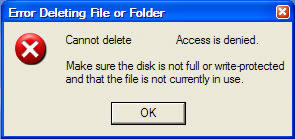follow the steps below carefully

Windows 95/98/ME
* If you are using Windows 95, 98, or Windows ME, the easiest way to remove an undeletable file is to boot to a DOS prompt and manually delete the file. Before you do this, you'll want to make a note of the location of the file including the entire path to it. Follow the steps below to delete these types of files.
* If you already know the path to the file, please skip to Step 7
* Click on Start, Find, Files and Folders
* Type the name of the undeletable file in the Named or Search For box
* Make sure the Look In box shows the correct drive letter
* Click on Find Now or Search Now and let the computer find the file
* Once the file is located, right-click on it and choose properties, make a note of the file location. Usually this is something similar to
c:\windows\system32\file.exe
Close the search box
* Locate a boot disk for your version of Windows. if you don't have a boot disk then follow the steps below to create one:
for windows 95/98/ME
FORMAT /S A:
COPY C:\AUTOEXEC.BAT A:
COPY C:\CONFIG.SYS A:
COPY C:\WINDOWS\SYSTEM.INI A:
COPY C:\WINDOWS\WIN.INI A:
On Windows XP, you can generally boot directly from the Windows XP CD-ROM, however in some cases you may still need a set of boot floppies. In this case, click one of the links below to download a program to create boot floppies for Windows XP Home or Windows XP Pro editions.
Windows XP Home Edition Boot Floppy Creator
Windows XP Pro Edition Boot Floopy Creator
* Shut down and restart your computer with the boot disk in your floppy drive.
* The computer will boot to a DOS prompt that will look similar to
c:\
* Type the following command and press Enter to delete the filer, substituting the phrase with the actual path and file name you discovered in Step 5 above.
del
Example:
del c:\windows\undeletablefile.exe
* Remove the boot disk in the floppy drive and restart your computer
* The file should now be deleted.
Windows XP
* If you already know the path to the file, please skip to Step 7
* Click on Start, Search, All Files and Folders
* Type the name of the undeletable file in the box shown
* Make sure the Look In box shows the correct drive letter
* Click Search and let the computer find the file
* Once the file is located, right-click on it and choose properties, make a note of the file location. Usually this is something similar to
c:\windows\system32\. (ex. c:\windows\system32\file.exe)
* Close the search box
* Click on Start, Run, and type CMD and Press Enter to open a Command Prompt window
* Leave the Command Prompt window open, but proceed to close all other open programs
* Click on Start, Run and type TASKMGR.EXE and press Enter to start Task Manager
* Click on the Processes tab, click on the process named Explorer.exe and click on End Process.
* Minimize Task Manager but leave it open
* Go back to the Command Prompt window and change to the directory where the file is located. To do this, use the CD command. You can follow the example below.
Example: to change to the Windows\System32 directory you would enter the following command and Press Enter
cd \windows\system32
* Now use the DEL command to delete the offending file. Type DEL where is the file you wish to delete.
Example: del undeletable.exe
* Use ALT-TAB to go back to Task Manager
* In Task Manager, click File, New Task and enter EXPLORER.EXE to restart the Windows shell.
* Close Task Manager
* Or you can try this
* Open Notepad.exe
* Click File>Save As..>
* locate the folder where your undeletable file is
* Choose 'All files' from the file type box
* click once on the file u wanna delete so its name appears in the 'filename' box
* put a " at the start and end of the filename
* (the filename should have the extension of the undeletable file so it will overwrite it)
* click save,
 RSS Feeds
RSS Feeds
 File Under :
File Under :






0 comments:
Post a Comment